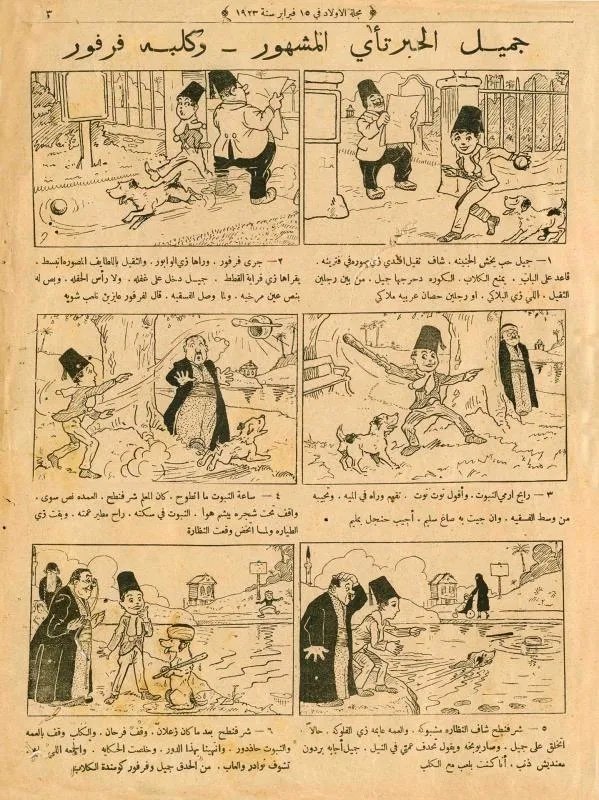Comics and the Arab World: George Khoury
George Khoury – better known to many as JAD – joined us on the podcast to talk about the history of Arab comics. We learnt about Khoury’s career to date, the duality of working as a political journalist and comic artist during the Lebanese civil war, and the unique role that comics have played in spreading nationalist propaganda throughout the Arab world. Here, we’re diving a little deeper into the world of comics, pairing our findings with some striking examples of the region’s best publications.
George Khoury’s Career As a Political Journalist and Comic Artist
George Khoury is a comics critic, artist, animator and political animator. Khoury has been working since the 80s and started out as a political journalist at al Nahar newspaper. It was around the same time that he started dabbling in comics and later established himself as the first author and artist for graphic novels aimed at adult readers in Lebanon and beyond. In 1989, he founded the first collective of comic artists in Lebanon and later the first animation department at Future Television in Beirut. Through his work there, he drove to create content for kids that still contained underlying social and political criticism.
As he touches on during our conversation, his goal from the outset has been to create work that his readers would take seriously. Underscoring this mission was a desire to change perceptions of comic book art which is often misconceived as a “lesser” art-form.
The decision to build out his professional persona under the pseudonym “JAD” was an attempt to delineate between his journalism and art and give his work the ability to traverse both the Arab and western worlds.
History of comics in the Arab world
Published in Egypt between 1923 and 1932, the adventures of Yamil in al Aulad are thought to be the Arab world’s first widely circulated comic. Around the same time, iconic western characters such as Mickey Mouse were being adapted into Arabic and published in magazines such as al Atfal.
The 1940s saw a boom for comics in the region – original characters were being created but further imports from the west also blossomed. Notably, KatKot magazine started publishing translations and arabised versions of Tintin.
Two decades later, Samer – another Egyptian creation and one of the region’s first significant comics – was published, selling 50,000 copies in its first edition. Samer offered socio-political commentary, conveying core values of Pan-Arabism and anti-imperialist sentiment through its stories and thus helping to cultivate an Arab nationalist imaginary that spoke to children.
The addition of magazines such as Sindibad crystallized the comic genre into what we know today. Sindibad offered readers a mix of “local stories..but also incorporated stories about ‘Farfor and Basbous,’ clearly modeled on Tom & Jerry.”
Ahmed Hejazi whose work "ridiculed the political class and Egyptian society in a healthy exercise of laughing at themselves” was considered one of the most influential artists of the time.
Lebanon’s first comic, Dunia al Ahdath, was created by Loren Rihany. As the only open market in the region, Lebanon played an instrumental role in importing apolitical western superhero comics into the region. Through the 1960s, Lebanon saw over 35 comic magazines appear.
The late 70s saw the launch of state-run magazines such as Syria’s Usama and Iraq’s Majallaty as well as the widely-loved Majid created by Ahmad Omar in the UAE in 1979. Although the region’s nascent comic book culture was taking hold – especially alongside the tides of anti-Imperialist sentiment – western influence still persisted. That’s why many of the region’s magazines continued to tell tales of famous western characters – although these were often Arabised.
The world of Arab comics has taken a while to establish itself. Pedro Rojo writing for IEMED points to Beirut and Cairo (as well as Tunis and Casablanca) as the gravitational poles of the still emerging Arab comic sphere. He also cites Khoury as a majorly influential figure – particularly through his work with JAD Workshop and its creation of the magazine Samandal.
Sources:
https://www.iemed.org/wp-content/uploads/2017/09/Arab-Comics.pdf
https://ithraeyat.ithra.com/editions/nostalgia/nine-decades-of-arabic-comics
Watch the full conversation with George Khoury (JAD) if you missed it!







